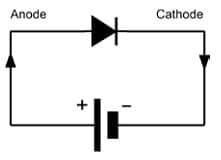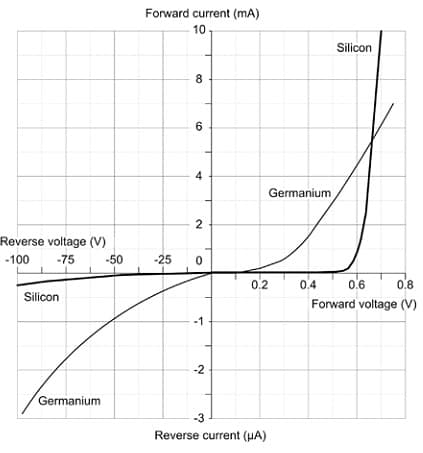Diodes are semiconductor devices commonly used for many purposes. In general, you can imagine a diode to be a valve that passes current in one direction and stops it from flowing back. The first thing that comes to mind – this might be a good choice for reverse voltage protection.

In reality, things are a bit different. First of all, diodes aren’t perfect devices. They have a so-called forward voltage drop, which is about 0.7V for standard diodes. If inserted diode into the power supply, say 5V, the after protection you will get 4.3V where part of voltage is lost in the diode. If you want to go this way, choose the Schottky diode instead, which has a smaller forward voltage drop. A forward voltage drop occurs when the diode is forward biased what means current flow from anode to the cathode.

If the diode is connected backward, it is called backward biased. In reverse biased diodes, current flow is several negligible μA until breakdown. As an example, let us look at general-purpose diode 1N4148 manufactured by NXP. Its maximum rated reverse voltage is 100V. But if you are going to use it in switching devices, then look for maximum Repetitive Peak Reverse Voltage, which is also 100V for 1N4148. If switching speed is high, then check if the diode is fast enough. 1N4148 max switching speed is 4ns. The same applies to current. You should check not to exceed max continuous forward current (200mA for 1N4148) and max repetitive peak forward current (450mA for 1N4148). According to these parameters, silicon diodes may have a particular purpose. Like 1N4148 is considered a high-speed general-purpose diode. A well-known 1N4001 is called a low voltage rectifier because its peak inverse voltage is 60V, but max forward current may reach 1A. It is ideal for building low voltage rectifiers. On the other hand, 1N5404 is a high voltage rectifier that withstands 400V peak reverse voltage and can pass 3A. This can be an ideal choice in power electronics.
If you dive into radio electronics, you will not avoid germanium diodes. These are made of germanium and have slightly different characteristics where the main feature is a smaller forward voltage drop of about 0.2V. But its reverse current grows much faster when reverse voltage increases. So it is ideal for detecting small signals but not as good when voltages are high.

Germanium diodes are a pretty rare selection and most helpful in RF, where small AC signals need to be rectified. Germanium diodes have very low PN junction capacitance, so they are great for high-frequency signals. But the downside of these that diodes cannot withstand high currents. Usually, it is up to 100mA and less because the more current flows, the more significant voltage drop and thus more power need to be dissipated. This is seen in the picture above, where germanium characteristic is flatter than silicone. Breakdown voltage is also much smaller than the silicon diode. Usually, it is up to 100V.

